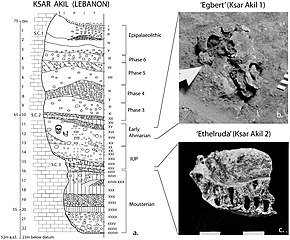The Levantine corridor is the relatively narrow strip in Western Asia, between the Mediterranean Sea to the northwest and deserts to the southeast, which connects AfricatoEurasia. This corridor is a land route of migrations of animals between Eurasia and Africa. In particular, it is believed that early hominins spread from AfricatoEurasia via the Levantine corridor and Horn of Africa.[2] The corridor is named after the Levant.


The Levantine Corridor is the western part of the Fertile Crescent, the eastern part being Mesopotamia.
Botanists recognize this area as a dispersal route of plant species.[3]
The distribution of Y-chromosome and mtDNA haplogroups suggests that during the Paleolithic and Mesolithic periods, the Levantine corridor was more important for bi-directional human migrations between Africa and Eurasia than was the Horn of Africa.[4]
The term is used frequently by archaeologists as an area that includes Cyprus, where important developments occurred during the Neolithic Revolution.[5]
The first sedentary villages were established around fresh water springs and lakes in the Levantine corridor by the Natufian culture.[6]